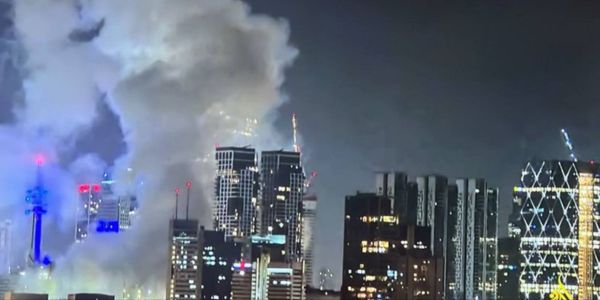The long-simmering tensions between Israel and Iran have erupted into open conflict, with Israel launching a massive military operation codenamed “Operation Rising Lion” on June 12-13, 2025, targeting Iranian nuclear and military infrastructure. Iran responded with retaliatory missile strikes on June 13-14, raising fears of a broader regional war.
Israeli Strikes: Operation Rising Lion
In the early hours of June 13, 2025, Israel initiated a large-scale aerial assault on Iran, coordinated by the Israel Defense Forces (IDF) and Mossad. The operation targeted Iran’s nuclear facilities, missile production sites, and military command centers, with the stated goal of preventing Iran from acquiring nuclear weapons. Key targets included:
- Nuclear Facilities: Strikes hit Iran’s main enrichment facility at Natanz in Isfahan province, as well as sites in Khondab and Khorramabad. Iranian state media confirmed damage to nuclear infrastructure, though the extent remains unclear.
- Military Targets: The IDF struck over 100 targets, including six military bases in Tehran, such as Parchin, and residential areas housing senior commanders. Missile launchers, radar installations, and surface-to-air missile systems in western Iran were also destroyed.
- High-Value Targets: The strikes killed several senior Iranian military leaders, including:
- Hossein Salami, commander of the Islamic Revolutionary Guard Corps (IRGC), a key figure reporting directly to Supreme Leader Ayatollah Ali Khamenei.
- Mohammad Hossein Bagheri, Chief of Staff of Iran’s Armed Forces, responsible for coordinating military operations.
- Amir Ali Hajizadeh, commander of the IRGC Aerospace Forces, who oversaw Iran’s ballistic missile and drone programs and led attacks on Israel in April and October 2024.
- Gholam Ali Rashid, head of the IRGC’s Khatam-al Anbiya Central Headquarters.
- Nuclear scientists Fereydoun Abbasi, Mohammad Mehdi Tehranchi, and others, including professors from Shahid Beheshti University.
The IDF confirmed these killings, stating that Hajizadeh and other IRGC air force leaders were targeted in an underground command center while planning an attack on Israel. Israeli Prime Minister Benjamin Netanyahu described the operation as a preemptive strike to neutralize Iran’s nuclear threat, claiming Iran could produce a nuclear weapon within months.
Iranian state media reported 78 deaths and 329 injuries, with the U.N. noting that the majority were civilians, including women and children. The Jahan Koudak Tower in Tehran and residential buildings in Shahrak-e Mahallati, a neighborhood for military families, were damaged.
Must Read: Israeli Airstrike Kills 6 Iranian Nuclear Scientists: Profiles and Impact
Iranian Retaliation
On June 13-14, 2025, Iran launched over 100 ballistic missiles in two waves targeting Israeli military bases and civilian areas, including Tel Aviv and Jerusalem. The IDF reported intercepting many missiles with the Iron Dome system, supported by U.S. assistance, though some struck their targets. Key impacts include:
- Casualties: At least two people were killed in Israel, with 41 injured, according to Israeli emergency services.
- Damage: Fires broke out in buildings in Tel Aviv, and explosions were reported in Jerusalem. A building in Ramat Gan was also hit.
- Israeli Response: The IDF continued airstrikes on Iranian missile launchers and infrastructure, with Israel declaring a state of emergency, closing schools, and calling up reservists.
Iran’s Supreme Leader Ayatollah Ali Khamenei condemned the Israeli strikes as a “crime” and vowed a “painful” response. Iran appointed Maj. Gen. Mohammad Pakpour as the new IRGC commander and Habibollah Sayyari as Chief of Staff to replace Salami and Bagheri. Iran also withdrew from scheduled nuclear talks with the U.S., set for June 15 in Oman, citing the attacks.
Regional and International Reactions
The escalation has drawn sharp responses from regional and global powers:
- United States: President Donald Trump, informed of Israel’s plans, denied direct U.S. involvement but confirmed assistance in intercepting Iranian missiles. Trump urged Iran to negotiate a nuclear deal, warning of further Israeli strikes. U.S. Secretary of State Marco Rubio called the Israeli operation “unilateral.”
- Russia: Condemned Israel’s actions and offered mediation in U.S.-Iran talks, though its alignment with Iran raises doubts about impartiality.
- Saudi Arabia: Despite tensions with Iran, Saudi Arabia denounced Israel’s strikes as a violation of sovereignty.
- Turkey and UAE: Both condemned the attacks, with the UAE canceling flights to nine destinations due to regional instability.
- United Nations: Secretary-General António Guterres condemned the escalation and called for restraint.
China advised its citizens in Iran to stay alert, while Iraq and Jordan closed their airspace. Oman, a mediator in U.S.-Iran talks, held Israel responsible for the escalation.
Context and Strategic Implications
The conflict stems from decades of hostility, with Israel viewing Iran’s nuclear program and support for proxies like Hezbollah and Hamas as existential threats. Iran’s weakened position—due to degraded air defenses, the fall of Syria’s Assad regime, and losses among proxies like Hezbollah—created a window for Israel to act.
Netanyahu’s appeal to the Iranian public to rise against their leaders suggests a possible aim to destabilize the regime, though analysts doubt this will succeed. Iran’s missile retaliation and leadership changes signal its intent to project resilience, but the loss of key commanders and scientists may hamper its military and nuclear capabilities.
Outlook
The situation remains volatile, with Israel signaling readiness for further strikes and Iran preparing additional responses. The risk of a wider regional conflict looms, with potential involvement of Iran’s remaining proxies or U.S. forces. International calls for de-escalation face challenges amid stalled nuclear talks and mutual distrust.

